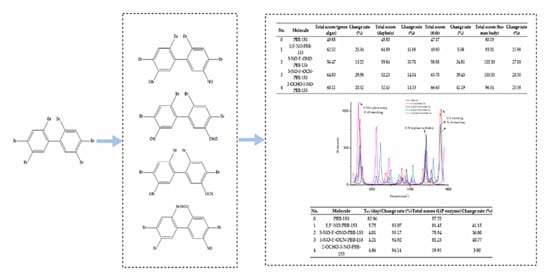Establishment of a CoMFA Model Based on the Combined Activity of Bioconcentration, Long-Range Transport, and Highest Infrared Signal Intensity and Molecular Design of Environmentally Friendly PBB Derivatives
Abstract
1. Introduction
2. Materials and Methods
2.1. Data Sources
2.2. Expression of Combined Activities of Bioconcentration, Long-Range Transport, and Infrared Signal Intensity of PBBs Based on the Threshold Method
2.3. Establishment of 3D-QSAR Model of the Combined Activity of PBBs Bioconcentration, Long-Range Transport, and Infrared Signal Intensity
2.4. Molecular Stability and Functional Evaluation of PBB Derivatives Based on Gaussian Calculation
2.5. Food Chain Analysis Based on Molecular Docking before and after Modification
3. Results and Analysis
3.1. Evaluation of the Combined Activity of Bioconcentration, Long-Range Transport, and Infrared Signal Intensity of PBBs
3.2. Establishment and Evaluation of CoMFA Model for the Combined Activity of PBBs Molecular Bioconcentration, Long-Range Transport, and Infrared Signal Intensity
3.2.1. Establishment of CoMFA Model for Combined Activity of PBBs Molecular Bioconcentration, Long-Range Transport, and Infrared Signal
3.2.2. Analysis of Contour Maps of Combined Activity CoMFA Model
3.3. Molecular Design of PBB-153 Derivatives and Model Validation
3.3.1. Molecular Modification of PBB-153 Based on Combined Activity CoMFA Model
3.3.2. Validation of Combined Activity CoMFA Model
Validation of Combined Activity CoMFA Model through Single Activity Evaluation
Validation of Combined Activity CoMFA Model Based on the Contour Maps of Single Activity and Combined Activity CoMFA Models
3.4. Molecular Properties Evaluation of PBB-153 Derivatives
3.4.1. Environmental Stability and Functionality Evaluation of PBB-153 Derivatives
3.4.2. Evaluation of Environmental Friendliness of PBB-153 Derivatives
3.5. Mechanism Analysis for Improvement of PBB-153 Derivatives in the Bioconcentration
3.6. Mechanism Analysis for Improvement of PBB-153 Derivatives in Long-Range Transport
3.7. Mechanism Analysis for Improvement of PBB-153 Derivatives in the Highest Infrared Signal Intensity
4. Conclusions
Supplementary Materials
Author Contributions
Funding
Institutional Review Board Statement
Informed Consent Statement
Data Availability Statement
Conflicts of Interest
References
- Lauby-Secretan, B.; Loomis, D.A.N.A.; Baan, R.; El Ghissassi, F.; Bouvard, V.; Benbrahim-Tallaa, L.; Guha, N.; Grosse, Y.; Straif, K. Use of mechanistic data in the IARC evaluations of the carcinogenicity of polychlorinated biphenyls and related compounds. Environ. Sci. Pollut. Res. 2015, 23, 2220–2229. [Google Scholar] [CrossRef] [PubMed]
- Zhihua, L.; Panton, S.; Marshall, L.; Fernandes, A.; Rose, M.; Smith, F.; Holmes, M. Spatial analysis of polybrominated di-phenylethers (PBDEs) and polybrominated biphenyls (PBBs) in fish collected from UK and proximate marine waters. Chemosphere 2018, 195, 727–734. [Google Scholar] [CrossRef] [PubMed]
- Sun, R.; Pan, C.-G.; Peng, F.; Wu, Y.; Chen, X.; Mai, B. Alternative halogenated flame retardants (AHFRs) in green mussels from the south China sea. Environ. Res. 2020, 182, 109082. [Google Scholar] [CrossRef] [PubMed]
- Schlingermann, M.; Berrow, S.; Craig, D.; McHugh, B.; Marrinan, M.; O’Brien, J.; O’Connor, I.; Mudzatsi, E.; White, P.; Ryan, C. High concentrations of persistent organic pollutants in adult killer whales (Orcinus orca) and a foetus stranded in Ireland. Mar. Pollut. Bull. 2020, 151, 110699. [Google Scholar] [CrossRef]
- Ding, X.; Liu, J.; Wen, W. Brominated Flame Retardants in Edible Fishes from Three Gorges Reservoir, China. Tecnol. Cienc. Agua 2019, 10, 46–65. [Google Scholar] [CrossRef]
- Chokwe, T.B.; Okonkwo, J.O.; Sibali, L.L.; Ncube, E.J. Alkylphenol ethoxylates and brominated flame retardants in water, fish (carp) and sediment samples from the Vaal River, South Africa. Environ. Sci. Pollut. Res. 2015, 22, 11922–11929. [Google Scholar] [CrossRef] [PubMed]
- Wu, J.-P.; Mo, L.; Zhi, H.; Peng, Y.; Tao, L.; Ren, Z.-H.; Luo, X.-J.; Mai, B.-X. Hepatic ethoxyresorufin-O -deethylase induction in the common kingfisher from an electronic waste recycling site. Environ. Toxicol. Chem. 2016, 35, 1594–1599. [Google Scholar] [CrossRef]
- Chang, C.-J.; Terrell, M.L.; Marcus, M.; Marder, M.E.; Panuwet, P.; Ryan, P.B.; Pearson, M.; Barton, H.; Barr, D.B. Serum concentrations of polybrominated biphenyls (PBBs), polychlorinated biphenyls (PCBs) and polybrominated diphenyl ethers (PBDEs) in the Michigan PBB Registry 40 years after the PBB contamination incident. Environ. Int. 2020, 137, 105526. [Google Scholar] [CrossRef]
- Rosen, D.H.; Flanders, W.D.; Friede, A.; Humphrey, H.E.; Sinks, T.H. Half-life of polybrominated biphenyl in human sera. Environ. Health Perspect. 1995, 103, 272–274. [Google Scholar] [CrossRef]
- Blanck, H.M.; Marcus, M.; Hertzberg, V.; Tolbert, P.E.; Rubin, C.; Henderson, A.K.; Zhang, R.H. Determinants of polybrominated biphenyl serum decay among women in the Michigan PBB cohort. Environ. Health Perspect. 2000, 108, 147–152. [Google Scholar] [CrossRef]
- DeZiel, N.C.; Alfonso-Garrido, J.; Warren, J.L.; Huang, H.; Sjodin, A.; Zhang, Y. Exposure to Polybrominated Diphenyl Ethers and a Polybrominated Biphenyl and Risk of Thyroid Cancer in Women: Single and Multi-Pollutant Approaches. Cancer Epidemiol. Biomark. Prev. 2019, 28, 1755–1764. [Google Scholar] [CrossRef] [PubMed]
- Curtis, S.W.; Terrell, M.L.; Jacobson, M.H.; Cobb, D.O.; Jiang, V.S.; Neblett, M.F.; Gerkowicz, S.A.; Spencer, J.B.; Marder, M.E.; Barr, D.B.; et al. Thyroid hormone levels associate with exposure to polychlo-rinated biphenyls and polybrominated biphenyls in adults exposed as children. Environ. Health 2019, 18, 1–12. [Google Scholar] [CrossRef] [PubMed]
- Curtis, S.W.; Cobb, D.O.; Kilaru, V.; Terrell, M.L.; Kennedy, E.M.; Marder, M.E.; Barr, D.B.; Marsit, C.J.; Marcus, M.; Conneely, K.N.; et al. Exposure to polybrominated biphenyl (PBB) associates with genome-wide DNA methylation differences in peripheral blood. Epigenetics 2019, 14, 52–66. [Google Scholar] [CrossRef] [PubMed]
- Yang, Q.; Qiu, X.; Li, R.; Liu, S.; Li, K.; Wang, F.; Zhu, P.; Li, G.; Zhu, T. Exposure to typical persistent organic pollutants from an electronic waste recycling site in Northern China. Chemosphere 2013, 91, 205–211. [Google Scholar] [CrossRef] [PubMed]
- Vinggaard, A.M.; Araque, P.; Kiviranta, H.; Molina-Molina, J.; Rantakokko, P.; Laine, O.; Vartiainen, T.; Olea, N. PBDEs and PBBs in the adipose tissue of women from Spain. Chemosphere 2007, 66, 377–383. [Google Scholar] [CrossRef]
- Mwangi, J.K.; Lee, W.-J.; Wang, L.-C.; Sung, P.-J.; Fang, L.-S.; Lee, Y.-Y.; Chang-Chien, G.-P. Persistent organic pollutants in the Antarctic coastal environment and their bioaccumulation in penguins. Environ. Pollut. 2016, 216, 924–934. [Google Scholar] [CrossRef]
- Vetter, W.; Gall, V.; Skírnisson, K. Polyhalogenated compounds (PCBs, chlordanes, HCB and BFRs) in four polar bears (Ursus maritimus) that swam malnourished from East Greenland to Iceland. Sci. Total Environ. 2015, 533, 290–296. [Google Scholar] [CrossRef]
- McKinney, M.A.; Letcher, R.J.; Aars, J.; Born, E.W.; Branigan, M.; Dietz, R.; Evans, T.J.; Gabrielsen, G.W.; Muir, D.C.G.; Peacock, E.; et al. Regional contamination versus regional dietary differences: Understanding geographic variation in brominated and chlorinated contaminant levels in polar bears. Environ. Sci. Technol. 2011, 45, 896–902. [Google Scholar] [CrossRef]
- Xiao, D.H.; Xiao, Q.; Zhou, M.H.; Liu, Y.F.; Zhai, C.P.; Zheng, J.G. Qualitative Analysis of polybrominated biphenyls and polybrominated biphenyl ether in electronic and electrical appliances by infra-red spectrometric method. China Plast. 2005, 19, 74–78. [Google Scholar]
- Ren, Z.; Wang, Y.; Xu, H.; Li, Y.; Han, S. Fuzzy Comprehensive Evaluation Assistant 3D-QSAR of Environmentally Friendly FQs to Reduce ADRs. Int. J. Environ. Res. Public Health 2019, 16, 3161. [Google Scholar] [CrossRef]
- Han, Z.; Yang, L.; Du, M.; Li, Y. A novel pharmacophore model on PAEs’ estrogen and thyroid hormone activities using the TOPSIS and its application in molecule modification. Environ. Sci. Pollut. Res. 2020, 27, 38805–38818. [Google Scholar] [CrossRef] [PubMed]
- Gu, W.; Li, Q.; Li, Y. Environment-friendly PCN derivatives design and environmental behavior simulation based on a multi-activity 3D-QSAR model and molecular dynamics. J. Hazard. Mater. 2020, 393, 122339. [Google Scholar] [CrossRef] [PubMed]
- Yang, L.Z.; Liu, M. 3D-QSAR model of polybrominated biphenyls tri-effect modified by standard deviation standardization method and its application in environmental friendly molecular modification. Chem. J. Chin. Univ. 2019, 40, 2471–2479. [Google Scholar]
- Qu, R.; Liu, H.X.; Feng, M.; Yang, X.; Wang, Z. Investigation on intramolecular hydrogen bond and some thermo-dynamic properties of polyhydroxylated pnthraquinones. J. Chem. Eng. Data. 2012, 57, 2442–2455. [Google Scholar] [CrossRef]
- Frisch, M.J.; Trucks, G.W.; Schlegel, H.B.; Scuseria, G.E.; Robb, M.A.; Cheeseman, J.R.; Scalmani, G.; Barone, V.; Mennucci, B.; Petersson, G.A. Gaussian 09 (Revision, A.02); Gaussian Inc.: Wallingford, CT, USA, 2009. [Google Scholar]
- Qiu, Y.L.; Xin, M.L.; Li, Y. Derivatization enhanced Raman characteristic vibration spectrum of PAEs based on pharma-cophore model. Spectrosc. Spect. Anal. 2018, 38, 441–447. [Google Scholar]
- Sun, R.H.; Du, M.J.; Li, Y. Evaluation of the enrichment and amplifcation effect of pentachlorobenzene with lower biocon-centration in the food chain before and after modification. Turk. J. Chem. 2019, 43, 1532–1551. [Google Scholar] [CrossRef]
- Gu, W.; Chen, Y.; Li, Y. Attenuation of the Atmospheric Migration Ability of Polychlorinated Naphthalenes (PCN-2) Based on Three-dimensional QSAR Models with Full Factor Experimental Design. Bull. Environ. Contam. Toxicol. 2017, 99, 276–280. [Google Scholar] [CrossRef]
- Jeong, J.A.; Cho, H.; Jung, S.Y.; Kang, H.B.; Park, J.Y.; Kim, J.; Choo, D.J.; Lee, J.Y. 3D QSAR studies on 3,4-dihydroquinazolines as T-type calcium channel blocker by comparative molecular similarity indices analysis (CoMSIA). Bioorg. Med. Chem. Lett. 2010, 20, 38–41. [Google Scholar] [CrossRef]
- Sheng, C.; Zhang, W.; Ji, H.; Zhang, M.; Song, Y.; Xu, H.; Zhu, J.; Miao, Z.; Jiang, Q.; Yao, J.; et al. Structure-Based optimization of azole antifungal agents by CoMFA, CoMSIA, and molecular docking. J. Med. Chem. 2006, 49, 2512–2525. [Google Scholar] [CrossRef]
- Yang, L.; Liu, M. A Double-Activity (Green Algae Toxicity and Bacterial Genotoxicity) 3D-QSAR Model Based on the Comprehensive Index Method and Its Application in Fluoroquinolones’ Modification. Int. J. Environ. Res. Public Health 2020, 17, 942. [Google Scholar] [CrossRef]
- Ren, J.; Wang, X.; Wang, C.; Gong, P.; Wang, X.; Yao, T. Biomagnification of persistent organic pollutants along a high-altitude aquatic food chain in the Tibetan Plateau: Processes mechanisms. Environ. Pollut. 2017, 220, 636–643. [Google Scholar] [CrossRef] [PubMed]
- Morikawa, H.; Erkin, O.C. Basic processes in phytoremediation and some applications to air pollution control. Chemosphere 2003, 52, 1553–1558. [Google Scholar] [CrossRef]
- Lee, B.X.Y.; Hadibarata, T.; Yuniarto, A. Phytoremediation Mechanisms in Air Pollution Control: A Review. Water Air Soil Pollut. 2020, 231, 1–13. [Google Scholar] [CrossRef]
- Jiang, L.; Wen, J.-Y.; Li, Y. Identification of vibration characteristics in infrared spectrum of polybrominated diphenyl ethers congeners based on Br substituents. Guang Pu Xue Yu Guang Pu Fen Xi Guang Pu 2014, 34, 1211–1216. [Google Scholar]
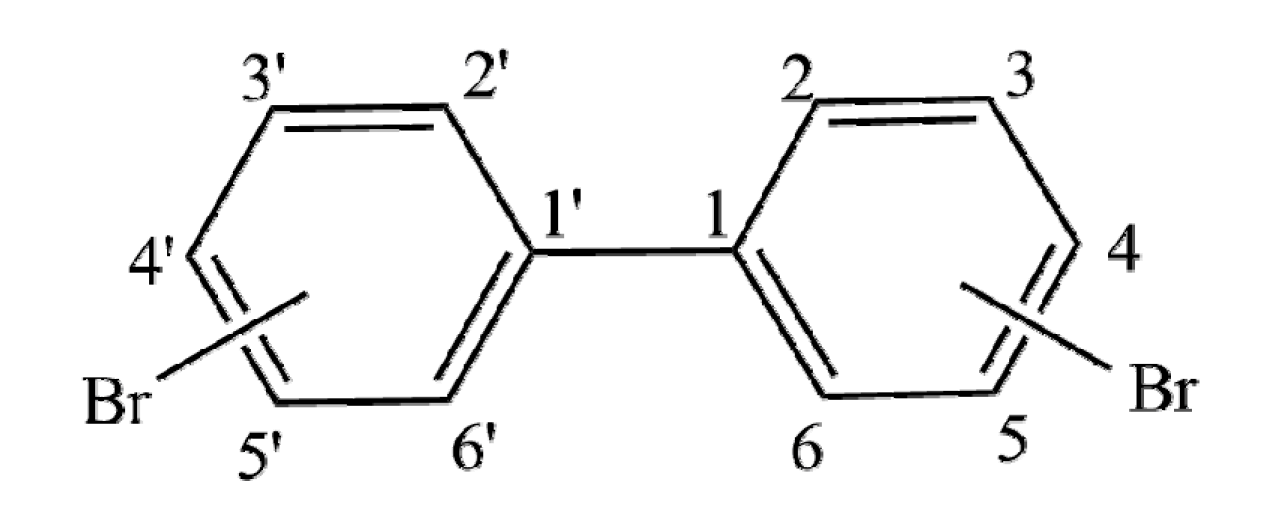

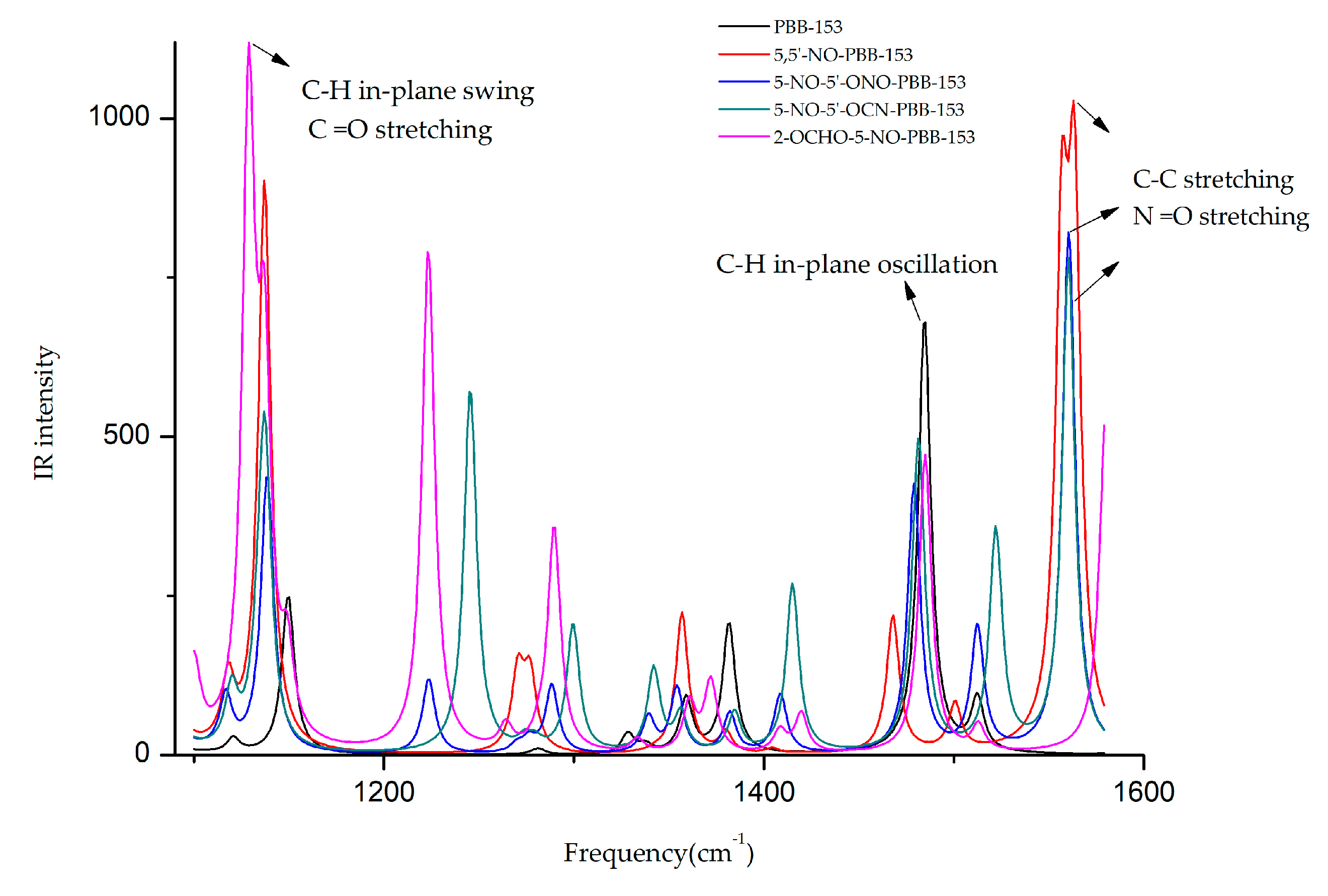
| Model | q2 | n | SEE | R2 | F | r2pred | SEP | Q2 | cSDEP | dq2/dr2yy |
|---|---|---|---|---|---|---|---|---|---|---|
| CoMFA | 0.76 | 8 | 0.06 | 0.95 | 67.79 | 0.65 | 0.19 | 0.53 | 0.18 | 1.17 |
| No. | Molecule | Combined Activity Value | Change Rate (%) |
|---|---|---|---|
| 0 | PBB-153 | 1.11 | |
| 1 | 5,5′-NO-PBB-153 | 1.02 | 8.29 |
| 2 | 5-NO-5′-ONO-PBB-153 | 0.87 | 21.80 |
| 3 | 5-NO-5′-OCN-PBB-153 | 0.81 | 27.39 |
| 4 | 2-OCHO-5-NO-PBB-153 | 1.02 | 8.02 |
| No. | Molecule | Log (IR Intensity) | Change Rate | Log (BCF) | Change Rate | Log (VP) | Change Rate (%) |
|---|---|---|---|---|---|---|---|
| 0 | PBB-153 | 2.84 | 2.22 | −7.67 | |||
| 1 | 5,5′-NO-PBB-153 | 3.01 | 5.98 | 1.87 | −15.59 | −9.89 | −28.90 |
| 2 | 5-NO-5′-ONO-PBB-153 | 2.92 | 2.79 | 1.78 | −19.87 | −9.09 | −18.49 |
| 3 | 5-NO-5′-OCN-PBB-153 | 2.89 | 1.96 | 1.74 | −21.63 | −9.26 | −20.74 |
| 4 | 2-OCHO-5-NO-PBB-153 | 3.05 | 7.41 | 2.13 | −3.92 | −8.60 | −12.15 |
| CoMFA Model | Combined Activity | Bioconcentration Activity | Long-Range Transport Activity | Infrared Intensity Activity |
|---|---|---|---|---|
| Steric field |  46.6% | 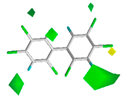 43.7% | 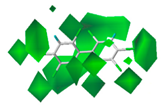 43.7% | 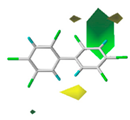 34.5% |
| Electrostatic field |  53.4% |  56.3% |  56.3% | 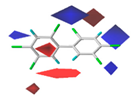 65.5% |
| No. | Molecule | Frequency | C–Br Bond Dissociation Enthalpy | Change Rate (%) |
|---|---|---|---|---|
| 0 | PBB-153 | 20.27 | 83.37 | |
| 1 | 5,5′-NO-PBB-153 | 22.68 | 82.04 | −1.59 |
| 2 | 5-NO-5′-ONO-PBB-153 | 22.84 | 82.94 | −0.52 |
| 3 | 5-NO-5′-OCN-PBB-153 | 21.88 | 81.90 | −1.76 |
| 4 | 2-OCHO-5-NO-PBB-153 | 16.80 | 83.35 | −0.02 |
| No. | Molecule | LC50 | Change Rate (%) |
|---|---|---|---|
| 0 | PBB-153 | 0.00022 | |
| 1 | 5,5′-NO-PBB-153 | 0.01 | 5404 |
| 2 | 5-NO-5′-ONO-PBB-153 | 0.05 | 22,836 |
| 3 | 5-NO-5′-OCN-PBB-153 | 0.17 | 78,799 |
| 4 | 2-OCHO-5-NO-PBB-153 | 0.24 | 111,827 |
| No. | Molecule | Total Scores (Green Algae) | Change Rate (%) | Total Scores (Daphnia) | Change Rate (%) | Total Scores (Fish) | Change Rate (%) | Total Scores (Human Body) | Change Rate (%) |
|---|---|---|---|---|---|---|---|---|---|
| 0 | PBB-153 | 49.88 | 45.80 | 47.17 | 80.19 | ||||
| 1 | 5,5′-NO-PBB-153 | 62.52 | 25.34 | 64.89 | 41.68 | 49.80 | 5.58 | 93.01 | 15.98 |
| 2 | 5-NO-5′-ONO-PBB-153 | 56.47 | 13.22 | 59.86 | 30.71 | 58.88 | 24.81 | 102.00 | 27.19 |
| 3 | 5-NO-5′-OCN-PBB-153 | 64.83 | 29.98 | 52.23 | 14.04 | 65.78 | 39.45 | 103.05 | 28.50 |
| 4 | 2-OCHO-5-NO-PBB-153 | 60.11 | 20.52 | 52.45 | 14.53 | 66.60 | 41.19 | 96.54 | 20.38 |
| No. | Molecule | T1/2 (day) | Change Rate (%) | Total Scores (LiP Enzyme) | Change Rate (%) |
|---|---|---|---|---|---|
| 0 | PBB-153 | 82.96 | 57.70 | ||
| 1 | 5,5′-NO-PBB-153 | 5.75 | 93.07 | 81.45 | 41.15 |
| 2 | 5-NO-5′-ONO-PBB-153 | 4.01 | 95.17 | 78.94 | 36.80 |
| 3 | 5-NO-5′-OCN-PBB-153 | 4.21 | 94.92 | 81.23 | 40.77 |
| 4 | 2-OCHO-5-NO-PBB-153 | 4.86 | 94.14 | 59.95 | 3.90 |
Publisher’s Note: MDPI stays neutral with regard to jurisdictional claims in published maps and institutional affiliations. |
© 2021 by the authors. Licensee MDPI, Basel, Switzerland. This article is an open access article distributed under the terms and conditions of the Creative Commons Attribution (CC BY) license (http://creativecommons.org/licenses/by/4.0/).
Share and Cite
Yang, L.; Li, M.; Liu, M. Establishment of a CoMFA Model Based on the Combined Activity of Bioconcentration, Long-Range Transport, and Highest Infrared Signal Intensity and Molecular Design of Environmentally Friendly PBB Derivatives. Polymers 2021, 13, 356. https://doi.org/10.3390/polym13030356
Yang L, Li M, Liu M. Establishment of a CoMFA Model Based on the Combined Activity of Bioconcentration, Long-Range Transport, and Highest Infrared Signal Intensity and Molecular Design of Environmentally Friendly PBB Derivatives. Polymers. 2021; 13(3):356. https://doi.org/10.3390/polym13030356
Chicago/Turabian StyleYang, Luze, Minghao Li, and Miao Liu. 2021. "Establishment of a CoMFA Model Based on the Combined Activity of Bioconcentration, Long-Range Transport, and Highest Infrared Signal Intensity and Molecular Design of Environmentally Friendly PBB Derivatives" Polymers 13, no. 3: 356. https://doi.org/10.3390/polym13030356
APA StyleYang, L., Li, M., & Liu, M. (2021). Establishment of a CoMFA Model Based on the Combined Activity of Bioconcentration, Long-Range Transport, and Highest Infrared Signal Intensity and Molecular Design of Environmentally Friendly PBB Derivatives. Polymers, 13(3), 356. https://doi.org/10.3390/polym13030356




